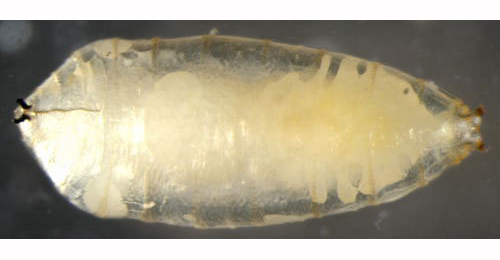|
||||||
|
Ophiomyia
beckeri (Hendel, 1923) Melanagromyza
beckeri Hendel, 1923b. Konowia 2: 145 |
||||||||||||||||||||||||||||||||||||||||||||||||||||||||||||||||||||||||||||||||
|
Leaf-miner: A white mine along mid-rib, with offshoots into leaf blade. Pupation internal at base of mid-rib. In Asteraceae the larva mostly lives as a borer in the midrib of the leaves. From there short corridors are made into the blade. Also a corridor can be made overlying the midrib. In Euphorbia a small mine is made in the bracts of the inflorescence. The final mine strongly resembles the one of Liriomyza strigata, but the branches are vritually free from frass; this is acccumulated in the resting place of the larva, in the base of the midrib. There also pupation takes place (Bladmineerders van Europa). Forms a mine along the midrib and has feeding spurs into the leaf. Pupation is in the mine at the base of the midrib (British leafminers). Larva: The larvae of flies are leg-less maggots without a head capsule (see examples). They never have thoracic or abdominal legs. They do not have chewing mouthparts, although they do have a characteristic cephalo-pharyngeal skeleton (see examples), usually visible internally through the body wall. The larva is described by de Meijere (1943) and illustrated in Bladmineerders van Europa. Antererior spiracles each with 7 bulbs; posterior spiracles each with 10-12 bulbs (Bladmineerders van Europa). Puparium: The puparia of flies are formed within the hardened last larval skin or puparium and as a result sheaths enclosing head appendages, wings and legs are not visible externally (see examples). Whitish; posterior spiracles on a short stalk, each with 10-12 bulbs. The puparium is illustrated in British leafminers and Bladmineerders van Europa.
Comments: Leontodon autumnalis is treated as Scorzoneroides autumnalis (Autumn Hawkbit) and Picris echioides is treated as Helminthotheca echioides (Bristly Oxtongue) by Stace (2010). Hosts in Great Britain and Ireland:
Hosts elsewhere: Time of year - mines: July-August. Time of year - adults: May. Distribution in Great Britain and Ireland: Widespread in south but not common. Kent (Sandwich), Essex (Thames Marshes), Oxfordshire (Bagley Wood), Dorest (Portland Studland), Somerset (Berrow), Glamorgan (Portcawl) (Spencer, 1972b: 60); Warwickshire (Coventry) (Robbins, 1991: 123); Cambridgeshire and Glamorgan (NBN Atlas). Also recorded in Ireland (Spencer, 1972b: 60). Distribution elsewhere: Widespread in continental Europe including Denmark, Finland (Spencer, 1976: 60), The Netherlands (Bladmineerders van Europa), Belgium (Scheirs, de Bruyn and von Tschirnhaus, 1995), Austria, Balearic Is., Canary Is., Czech Republic, Germany, Lithuania, Madeira, Poland, Sicily, Spanish mainland and Yugoslavia (Fauna Europaea). Also recorded in South Africa and India (Spencer, 1976: 60). NBN Atlas links to known host species: British and Irish Parasitoids in Britain and elsewhere:
|
| Last updated 10-Jul-2019 Brian Pitkin | ||

